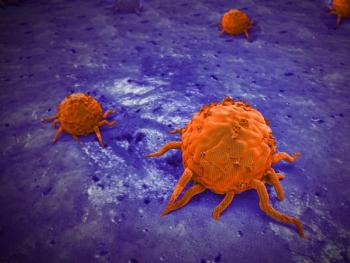
Oncology NEWS International
- Oncology NEWS International Vol 9 No 9
- Volume 9
- Issue 9
New Antiangiogenesis Strategies Target Vascular Endothelial Growth Factors
HOUSTON-Remember the enthusiastic reports in the popular press that antiangiogenic therapy would provide a quick cancer cure by starving tumors of their blood supply? Lee Ellis, MD, quoted H. L. Mencken in describing the aftermath of those reports: “All complex problems have simple answers that are invariably wrong.”
HOUSTONRemember the enthusiastic reports in the popular press that antiangiogenic therapy would provide a quick cancer cure by starving tumors of their blood supply? Lee Ellis, MD, quoted H. L. Mencken in describing the aftermath of those reports: All complex problems have simple answers that are invariably wrong.
Speaking at a clinical investigators workshop, Dr. Ellis noted, however, that newer work, particularly that directed at vascular endothelial growth factor (VEGF), has opened several promising new veins of research. The workshop was sponsored by Pharmacia Oncology and the University of Texas M. D. Anderson Cancer Center, where Dr. Ellis is Associate Professor of Surgery and Cancer Biology.
Understanding biology is the basis of developing effective therapies, Dr. Ellis said. The tumor and normal host tissues can both contribute to angiogenesis. Research into the process of neovascularization suggests four potential antiangiogenic strategies directed either at angiogenic factors or at endothelial cell survival factors:
- Decrease the activity of angiogenic factors.
- Decrease the activity of endothelial cell survival factors.
- Increase the activity of naturally occurring antiangiogenic agents by endogenous or exogenous means.
- Indirectly down-regulate the activity of angiogenic/survival factors.
Anti-VEGF Approaches
VEGF emerged as a target because it is associated with progression and poor prognosis in several tumor types, including colon, breast, prostate, central nervous system, gastric, hepatocellular, ovarian, and melanoma. Dr. Ellis described two anti-VEGF approaches: antibodies to VEGFR2, and tyrosine kinase inhibitors to VEGFR2.
The monoclonal antibody DC101 has been associated with decreased angiogenesis, a lower proliferative index of tumor cells, an increase in apoptosis, and a decrease in tumor blood vessel counts. Similar effects have been seen with the tyrosine kinase inhibitors SU5416 and SU6668.
This raised the question of whether endothelial cell apoptosis precedes tumor cell apoptosis. Research into this question showed that a wave of endothelial cell apoptosis precedes a wave of tumor cell apoptosis [following anti-VEGF treatment], Dr. Ellis stated. VEGF is a survival factor for tumor endothelium, and anti-VEGF treatment induces tumor endothelial cell apoptosis [in animal models].
Anti-VEGF treatment has been associated with increased survival in mice with metastatic colorectal cancer, but not with cures. This may be the result of redundancy in survival factors for tumor endothelium and in angiogenic factors in tumors and host cells, Dr. Ellis noted.
Low-dose Metronomic Therapy
Conventional chemotherapeutic agents are also being studied as antiangiogenic therapy in the form of low-dose metronomic therapy. The principle is that continuous low-dose chemotherapy will damage vasculature and not allow time for endothelial cell repair, Dr. Ellis explained, referring to work done by laboratories headed by Judah Folkman, MD, of Harvard Medical School, Cambridge, Massachusetts, and Robert S. Kerbel, PhD, of Sunnybrook Health Science Center, Toronto, Canada.
Dr. Ellis described one promising recent study reported by Dr. Kerbel and colleagues in the April 15, 2000, issue of the Journal of Clinical Investigation. That study combined low-dose vincristine (Oncovin) with an anti-VEGFR2 antibody, on the premise that vincristine would damage the endothelium and the antibody would block the survival of the endo-thelial cells. Dr. Ellis said that tumor regression sustained to 210 days had been observed in animal models with this combination.
Clinical use is likely to require more carefully tailored agents, however. Tumor endothelium is phenotypically distinct, Dr. Ellis said, and each tumor has its own angiogenic zip code, using a term coined by Erkki Ruoslahti, MD, PhD, President and CEO of the Burnham Institute in LaJolla, California. For example, Dr. Ellis continued, VEGF expression is higher in the primary tumor than in liver metastases, and tumors with low VEGF may not respond as well to anti-VEGF treatment. He added that optimal antiangiogenic therapy would require knowledge of the angiogenic profile of individual tumors.
An additional concern is the potential for side effects from anti-angiogenesis drugs. Dr. Ellis pointed out that the heart and the central nervous system both use angiogenesis as part of their normal repair mechanisms and could be adversely affected by broad blocking or inhibition of this process.
Articles in this issue
over 25 years ago
Soy’s Effect on Breast Cancer Remains Uncertainover 25 years ago
STAR Enrollment Tops 6,000 in First Year of Recruitmentover 25 years ago
New rhTPO Being Tested in Three Trialsover 25 years ago
New Research Centers Target How Market Forces Affect Health Careover 25 years ago
PRIMATOM System Combines CT Scanning With Radiation TherapyNewsletter
Stay up to date on recent advances in the multidisciplinary approach to cancer.




















































































